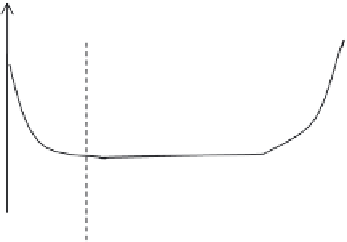Information Technology Reference
In-Depth Information
Infant
Mortality
End of
Life
Useful Life
λ
Time
FIGURE 14.A.1
Bath tub curve.
on individual failures, the causes of failures, or relationships between failures,
except that the likelihood for failures to occur varies across time according
to the given probability function. Reliability engineering is concerned with
meeting the specified probability of success at a specified statistical confidence
level.
2. Reliability is predicated on “intended function;” generally, this is taken to mean
operation without failure. However, even if no individual part of the system
fails, but the system as a whole does not do what was intended, then it is still
charged against the system reliability. The system requirements specification
is the criterion against which reliability is measured.
3. Reliability applies to a specified period of time. In practical terms, this means
that a system has a specified chance that it will operate without failure before
time. Reliability engineering ensures that components and materials will meet
the requirements during the specified time. Units other than time sometimes
may be used. The automotive industry might specify reliability in terms of
miles; the military might specify reliability of a gun for a certain number of
rounds fired. A piece of mechanical equipment may have a reliability rating
value in terms of cycles of use.
4. Reliability is restricted to operation under stated conditions. This constraint is
necessary because it is impossible to design a system for unlimited conditions.
A Mars Rover will have different specified conditions than the family car.
The operating environment must be addressed during design and testing. Also,
that same rover may be required to operate in varying conditions requiring
additional scrutiny.
The bath tub curve (Figure 14.A.1) is used widely in reliability engineering. It
describes a particular form of the hazard function that comprises three phases:
1. The first phase is a decreasing failure rate, known as early failures.
2. The second phase is a constant failure rate, known as random failures.
3. The third phase is an increasing failure rate, known as wear-out failures.




Search WWH ::

Custom Search